Creating hand-painted pottery is a fun and rewarding way to express your creativity.
Whether you’re a seasoned crafter or just starting out, this art form allows you to personalize items in unique ways. With the right materials and techniques, you can make beautiful pieces that truly stand out and reflect your personal style.

You don’t need a kiln or fancy equipment to begin your pottery journey.
By exploring different painting techniques and finding inspiration in everyday objects, you can transform simple ceramics into eye-catching art.
This guide will walk you through the essentials to help you get started on your hand-painted pottery adventure.
Choose Bold Colors
Choosing bold colors is key to making your hand-painted pottery stand out.
Bright, vibrant shades can transform a simple piece into a striking focal point in any room.
Start by selecting colors that contrast well.
Pairing deep blues with bright yellows or vivid reds can create eye-catching combinations.
Consider the overall theme of your space to ensure your pottery complements your decor.
Don’t shy away from experimenting.
Try layering colors or using techniques like splattering or sponging for added texture.
This can enhance the visual appeal and draw attention to your creations.
Use a limited color palette for a cohesive look.
A few bold colors can make a stronger statement than a wide array of shades.
This approach keeps the design focused and impactful.
Ultimately, let your personality shine through.
Choose colors that resonate with you and reflect your unique style.
This will make your pottery not just beautiful, but truly your own.
2) Incorporate Unique Patterns
Adding unique patterns to your hand-painted pottery can elevate it from simple to stunning.
Think about using natural elements like leaves or flowers to create interesting designs.
You can also explore geometric shapes.
Using easy-to-make templates can help you create crisp, clean lines.
This method allows for controlled patterns that stand out beautifully.
For a more organic feel, try lace imprints.
They offer a textured look that is both modern and traditional.
Just press lace onto the clay before painting, and you’ll achieve a stylish finish.
Consider using different colors and layering techniques.
This can help your patterns pop and add depth to your pieces.
Experimenting with color combinations can lead to surprising results.
Don’t shy away from using stencils, either.
They provide a straightforward way to achieve detailed designs without the need for advanced skills.
Just make sure to secure them properly during painting.
With some practice and creativity, your hand-painted pottery will showcase your individual style and flair.
The key is to enjoy the process and let your imagination guide you.
Experiment with Textures
Texturing your pottery can add depth and interest to your pieces.
It’s a fun way to make your work truly unique.
You’ll find that no two textured pieces will ever look exactly the same.
Start by pressing various materials into your clay.
Items like sponges, lace, or even natural elements can create fascinating patterns.
Experimenting with different tools will also yield interesting results.
When hand building, try incorporating texture as you shape your pieces.
You can pinch, carve, or stamp designs as you go along.
This not only enhances the visual appeal but also adds a tactile element.
Consider using underglazes or slips to accentuate your textures.
Applying color after creating your texture can really make those details pop.
Most importantly, have fun with the process.
Let your creativity flow and don’t be afraid to try something new.
Each experiment is a chance to discover a technique that reflects your style.
4) Use Metallic Paints
Metallic paints can add a stunning touch to your hand-painted pottery.
They create a unique shimmer that catches the light beautifully.
When selecting metallic paint, choose ones specifically designed for ceramics.
These ensure durability and a smooth finish once fired.
Gold, silver, and copper are popular choices that stand out well on a variety of colors.
Before applying metallic paints, make sure your pottery piece is clean and dry.
This helps the paint adhere better and gives you a more polished look.
Consider layering the metallic paint over a base color for added depth.
You can also mix metallics with other paints to create custom colors and effects.
Applying the paint with fine brushes or sponges can help you achieve different textures.
Experiment with techniques to see what looks best on your pieces.
Don’t forget to follow the specific firing instructions provided by your paint manufacturer.
This ensures that your artwork remains vibrant and intact after firing.
5) Add Personal Design Touches

Adding your personal design touches can really make your hand-painted pottery unique.
Think about what represents you.
It could be a favorite color, pattern, or symbol.
Start with simple patterns like polka dots or stripes.
These are easy to paint and can be done in colors that resonate with you.
Monograms are another great option.
You can paint your initials or a special date, adding a meaningful element to your piece.
Consider adding small drawings or doodles that reflect your personality.
Whether it’s flowers, animals, or shapes, these small details make a big impact.
Don’t shy away from experimenting.
You might mix techniques, like combining painting with glazing, to enhance your design.
Remember, it’s about expressing who you are.
Let your creativity flow and have fun with the process!
Mix Traditional and Modern Styles
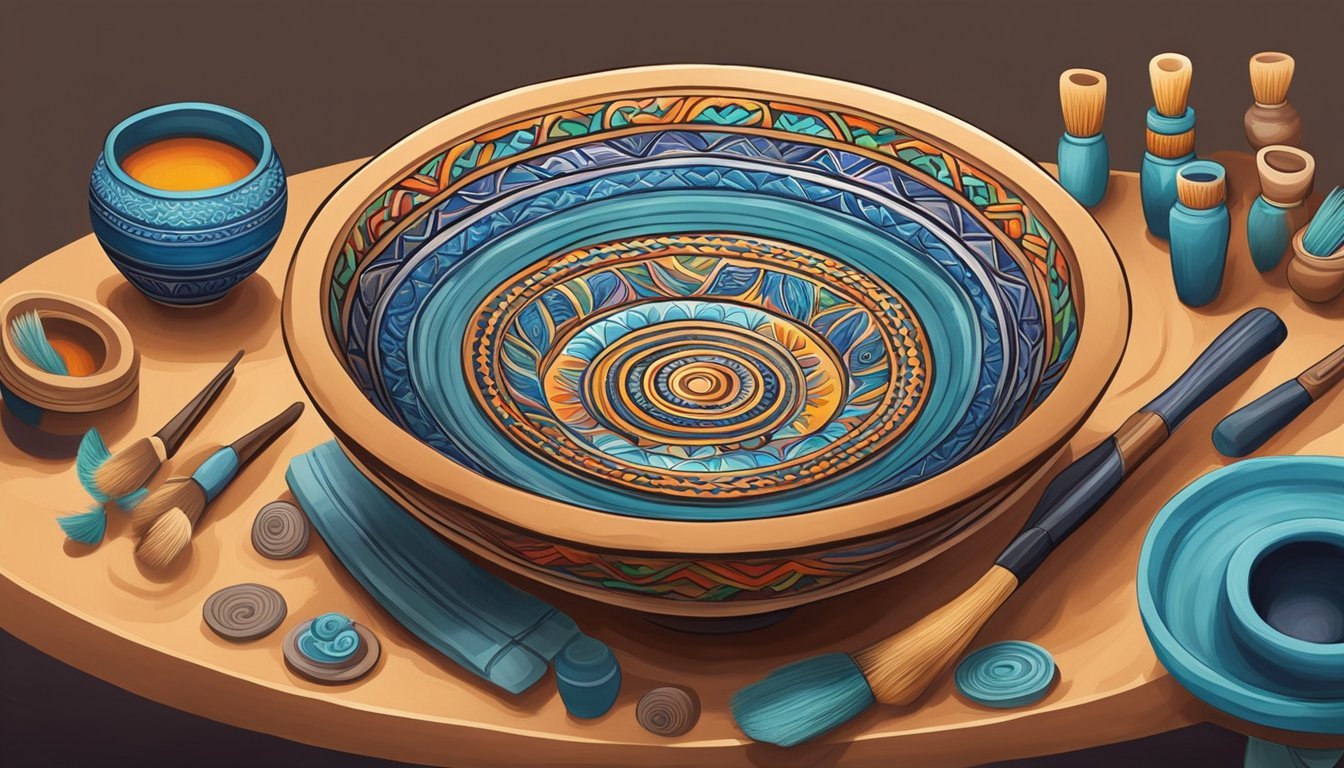
Blending traditional and modern styles can give your hand-painted pottery a unique flair.
Start by choosing classic designs that resonate with you, like floral patterns or geometric shapes.
Next, pair these elements with contemporary color palettes.
Think about using vibrant hues that pop against the classic motifs.
A hand-painted floral design can look fresh when set against a bold background.
Don’t be afraid to experiment.
Mixing textures can also enhance the look.
For instance, you might use a matte finish for traditional designs and a glossy glaze for modern touches.
This contrast will draw attention to both styles.
Arrange your pottery thoughtfully.
Displaying traditional pieces alongside modern ones creates a focal point.
Your collection can tell a story that showcases your personality.
Finally, remember to have fun with the process.
This blend allows for creativity and self-expression, making your pottery truly one-of-a-kind.
7) Include Handwritten Elements

Adding handwritten elements to your pottery can create a personal touch that makes your pieces stand out.
Consider using a brush or a fine-tipped marker designed for ceramic surfaces to write words or phrases.
You can include quotes, names, or even doodles that resonate with you.
This adds character and can turn ordinary pottery into a cherished keepsake.
Another option is to use stencils for more controlled designs while still giving an organic feel.
The imperfect lines of handwritten text add warmth and authenticity to your work.
Mixing print with cursive can also create interesting contrasts.
Don’t be afraid to play with sizes and styles, since variety can lead to unique designs.
When you fire your pottery, make sure to follow the manufacturer’s guidelines for your writing materials.
This ensures your handwritten elements remain vibrant and durable.
8) Try Layering Techniques

Layering glazes can add depth and uniqueness to your hand-painted pottery.
Start with a solid base color and let it dry completely before adding the next layer.
This helps prevent cracking and bubbling, ensuring a smoother finish.
When applying additional layers, consider using a lower specific gravity glaze.
This creates thinner, more even coats.
You can brush, spray, or dip your piece to achieve different effects.
Make sure to allow plenty of drying time between each application.
Feel free to use a fan or simply leave your pottery out overnight to speed up the process.
Remember, patience is key here.
Experimenting with color combinations can lead to surprising results.
Overlaying different hues can create interesting visual textures.
Try a couple of test pieces first to see what works for you.
Lastly, enjoy the process.
Layering techniques give you the chance to express your creativity and make your pottery truly stand out.
Highlight with Gold Leaf

Adding gold leaf to your pottery can transform it into something truly special.
This technique involves applying thin sheets of gold to the surface, creating a stunning highlight.
Before you start, ensure your pottery is clean and dry.
You’ll need adhesive specifically for gold leaf, which allows it to bond effectively.
Apply the adhesive where you want the gold to adhere.
Carefully lay the gold leaf onto the adhesive.
You can use a soft brush to help smooth it down, removing any excess.
Remember, gold leaf is very delicate.
Handle it gently to avoid tearing.
After applying, allow your piece to dry completely.
If you want a more polished look, consider a topcoat or sealer to protect the gold leaf.
This not only enhances its shine but also makes it more durable.
Gold leafing adds a touch of elegance and can elevate your pottery’s overall aesthetic.
The radiant finish can highlight designs or patterns, making your work stand out even more.
10) Utilize Negative Space
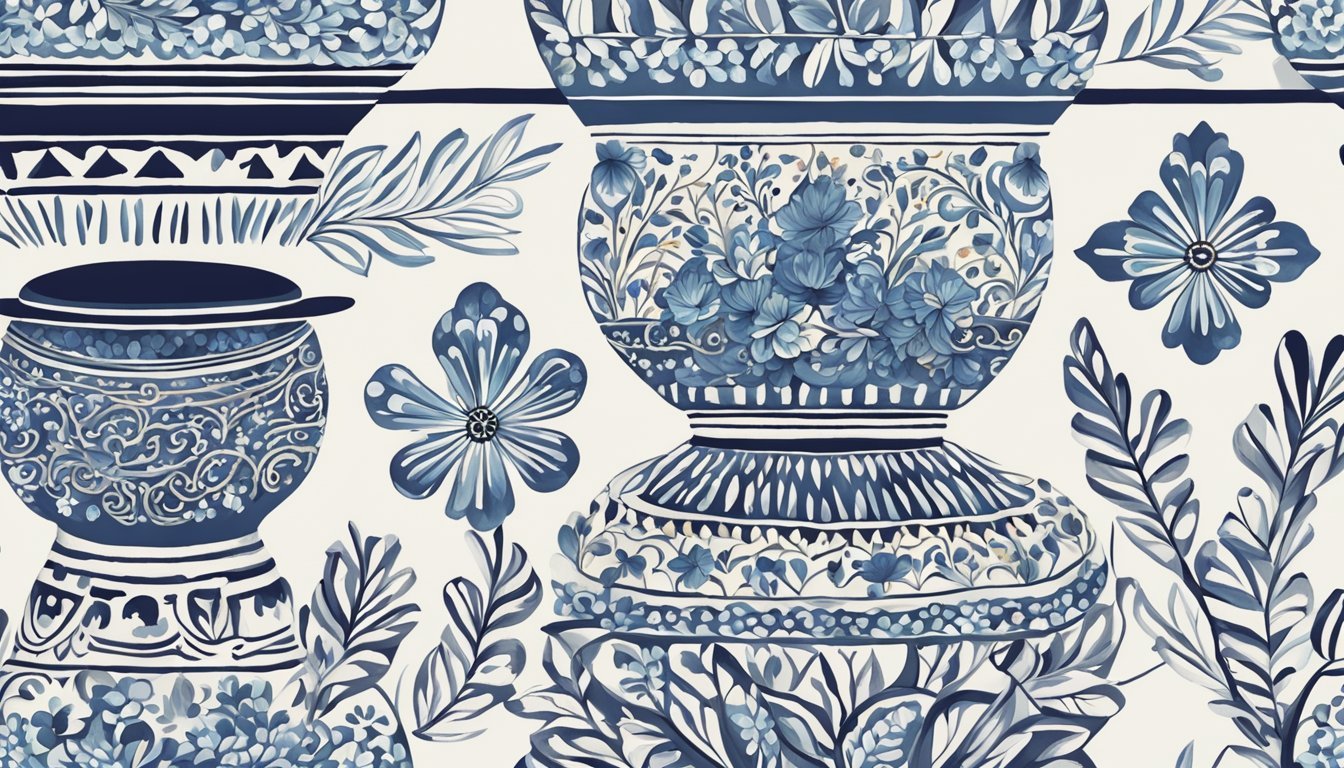
When creating hand-painted pottery, don’t forget about negative space.
This is the area around and between your painted elements.
It can be just as important as the designs themselves.
Using negative space wisely can help your artwork stand out.
Think about how the empty areas can enhance the shapes and colors you choose.
For example, if you paint a bold flower, leaving space around it can draw more attention to the flower itself.
Try experimenting with different arrangements.
You could position your designs to create an interesting balance with the negative space.
This strategy not only adds depth but also invites viewers to engage more with your piece.
Remember, negative space can make your pottery feel more dynamic.
Consider how light interacts with these spaces and how they influence the overall look.
With a bit of thought, you can transform ordinary pieces into striking art.
Choosing the Right Pottery Materials
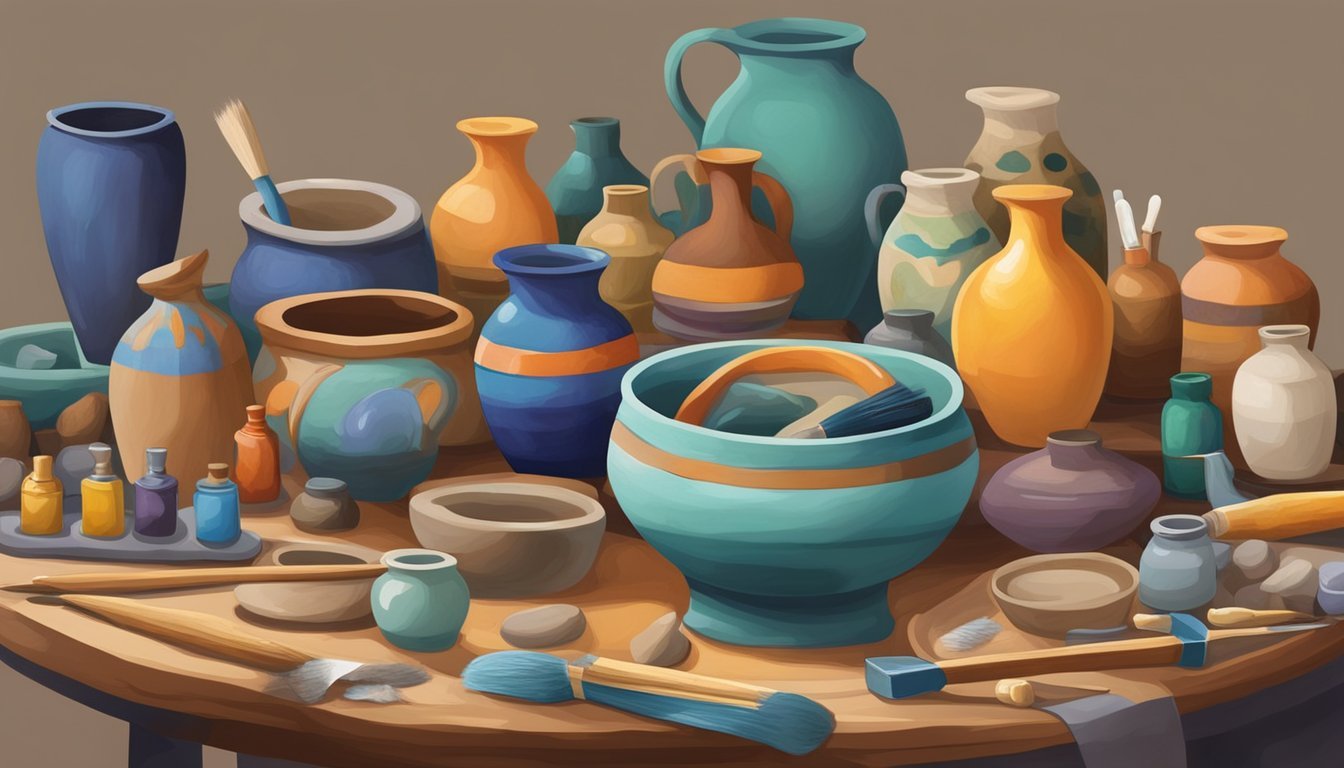
Selecting the right materials is essential for creating hand-painted pottery that truly stands out.
Quality clay and brushes will significantly impact your artwork’s durability and appearance.
Here’s what you need to consider.
Types of Clay for Hand-Painting
When it comes to hand-painted pottery, the choice of clay is crucial.
Here are some popular types:
- Earthenware: This clay is porous and has a smooth texture. It takes paint well but needs a glaze to become food-safe.
- Stoneware: Known for its durability, stoneware is less porous and suitable for functional pottery. It responds nicely to glaze and paint.
- Porcelain: This is a fine, elegant clay that works beautifully for detailed hand-painted designs. It requires higher firing temperatures and is less forgiving than earthenware.
Consider what you want your finished piece to be used for.
If it’s purely decorative, earthenware might suffice.
For functional items, stoneware or porcelain is a better choice.
Selecting Quality Brushes
The right brushes make a significant difference in your painting experience.
Here are some key aspects to keep in mind:
- Material: Look for brushes made from natural hair (like sable or ox) or high-quality synthetic fibers. Natural hair offers a smoother application, while synthetic brushes are sturdy and versatile.
- Size: Choose a range of brush sizes. Larger brushes work well for broad strokes and backgrounds, while finer brushes are perfect for intricate details.
- Shape: Different shapes serve various purposes. Flat brushes are ideal for coverage, round brushes excel at detail, and filbert brushes mix the two.
Investing in quality brushes will enhance your painting precision and help you achieve the look you desire.
Exploring Painting Techniques
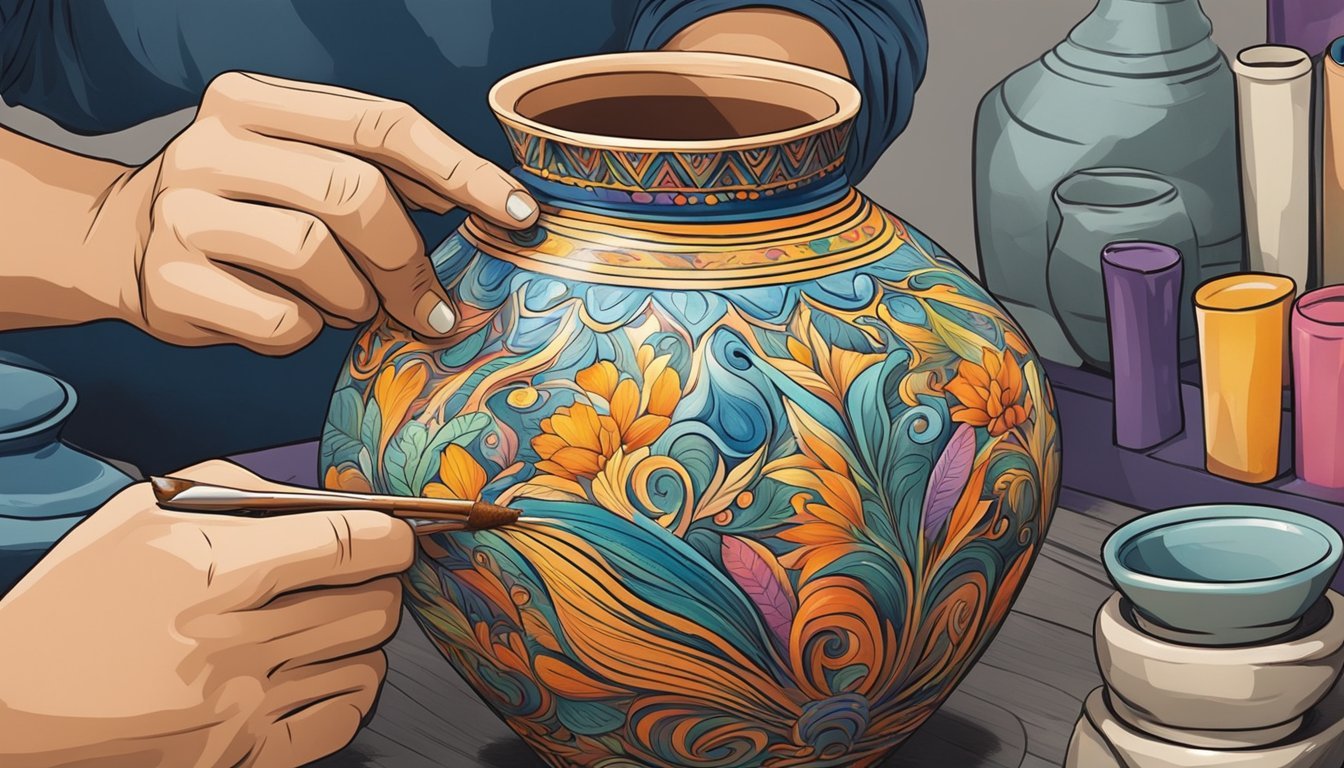
When creating hand-painted pottery, choosing the right painting techniques can significantly enhance the visual appeal of your pieces.
Utilizing underglazes and overglazes, along with mixing custom colors, allows you to achieve unique effects and vibrant finishes.
Using Underglazes and Overglazes
Underglazes are colored slip that you can apply to your pottery before a glaze is added.
They are perfect for detailed designs since they can be painted on with fine brushes.
This technique allows for a matte finish that can showcase intricate patterns.
After the underglaze has dried, a clear glaze can be applied on top.
Overglazes add a glossy finish and allow the colors beneath to shine through.
Make sure to follow the manufacturer’s instructions for firing temperatures, as each type of glaze can react differently.
Combining the two creates layers that can enrich your pottery’s look and feel.
Mixing Custom Colors
Mixing custom colors provides you with endless possibilities for your pottery.
Start by selecting your base color and then gradually add small amounts of other colors to achieve the desired shade.
Always test your color mix on a spare piece of clay before applying it to your project.
Using a palette and a variety of brushes can help you apply your custom colors effectively.
Remember that colors may change slightly after firing, so keep notes on your mixtures for future reference.
This trial-and-error approach allows for personal expression and can make your pottery truly unique.
Incorporating Unique Designs
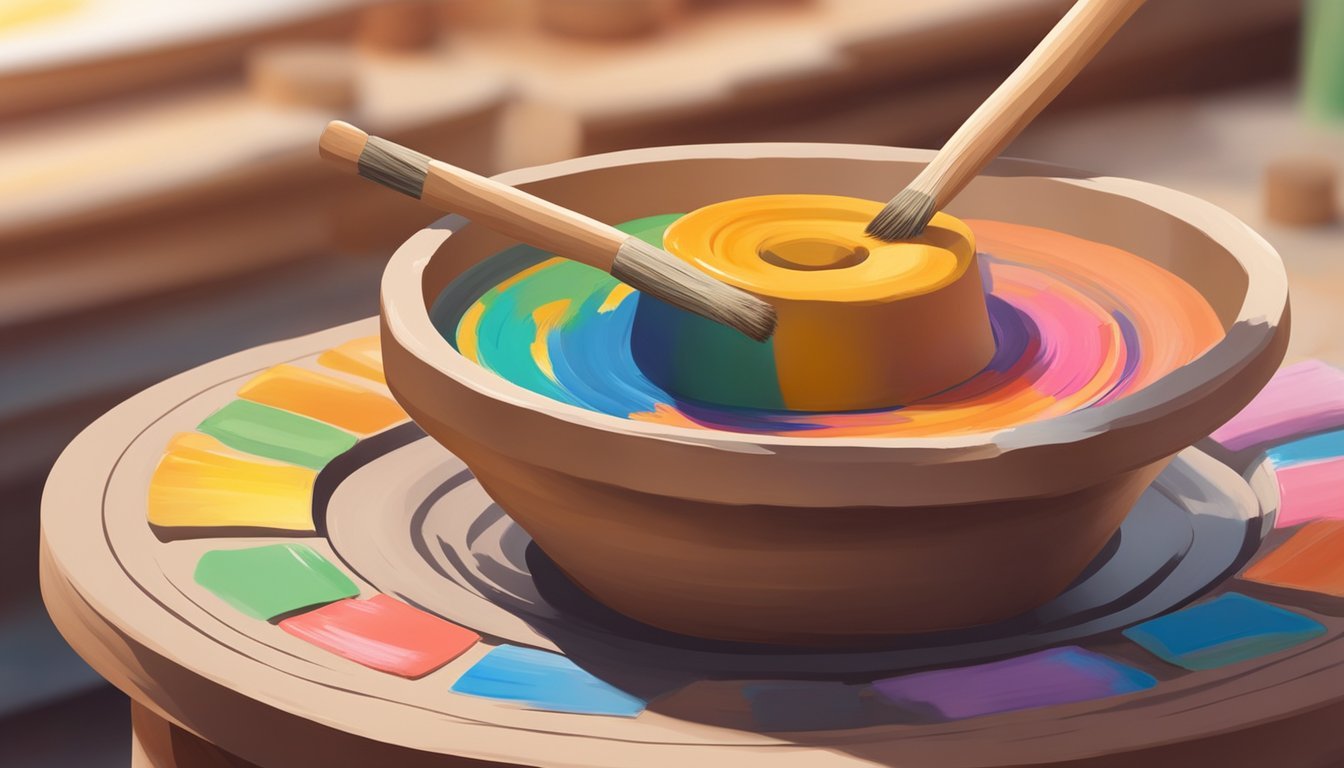
Adding unique designs to your hand-painted pottery can elevate your creations and make them truly standout pieces.
Personal touches not only reflect your style but also add a distinctive flair that can’t be found elsewhere.
Finding Inspiration
Look for inspiration everywhere—nature, art, or even everyday objects can spark fantastic ideas.
Start by keeping a sketchbook handy to jot down patterns, colors, or shapes that catch your eye.
Visiting art galleries or browsing online platforms like Pinterest can also provide a wealth of visual cues.
Don’t forget to explore traditional designs from various cultures.
Incorporating elements from different artistic backgrounds can give your pottery a unique, global appeal.
Moreover, consider themes that resonate with you personally.
This could include hobbies, favorite places, or even cherished memories.
Tapping into your experiences can lead to truly original designs.
Creating Personalized Patterns
Once you have some ideas, it’s time to create your personalized patterns.
Start with basic geometric shapes or floral designs and modify them to suit your taste.
Experiment with layering colors and shapes for added depth.
Using stencils can simplify this process and help maintain consistency across your pieces.
You might also want to explore techniques like splattering or sponge painting for a more abstract approach.
Remember to test your designs on small pieces first.
This way, you can see how colors and patterns work before committing to larger projects.
Pay attention to how different glazes interact with your designs—it can change the look completely once fired!


